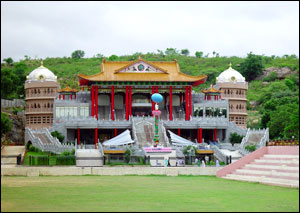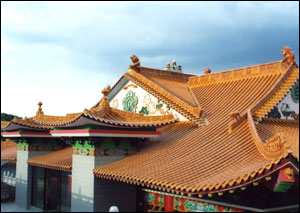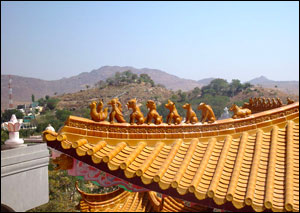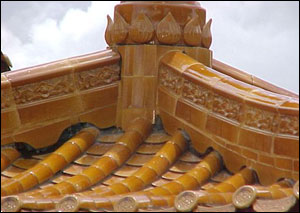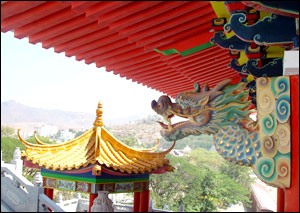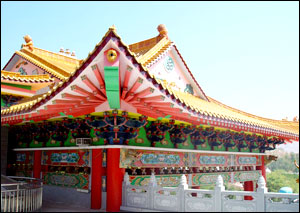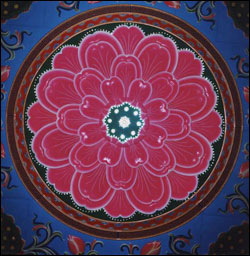 |
 |
 |
| Volume
3 - Issue 2, FEB 2005 |
[ This page has lots of Graphics. Allow time for the images to download. ]
How would you sum up the Lord and His Works, His Life, Mission and Message to a friend? With a few words? Surely too short. A book - little better. How about a whole building with beautiful exhibits, wonderful pictures and breathtaking artefacts dedicated to Him. That's just what devotees felt inspired to do to commemorate the Sri Sathya Sai Avatar's 75 years of service to humanity. That dream building came alive as the Chaitanya Jyoti Museum. 'Chaitanya' means 'consciousness' and 'Jyothi' is 'light'. So, the 'Light of Consciousness' is a mammoth attempt to portray Swami and His Message by way of the building's architecture and its contents of 90 exhibits based on the life and Teachings of the omni-faceted Lord. But can a mere building do justice to His Love? It is after all to be apprehended by the five senses, which Swami says we have to transcend to glimpse His Love. But like the finger pointing to the moon the Chaitanya Jyoti Museum is a bold and beautiful endeavour to facilitate our awareness of the Divine - the Light of Consciousness within. Rising from the rocky hillside it stuns the devotee with its grandeur and originality. Bhagavan paid the building a fitting tribute when He saw the first plans, asking if it was possible to build it; He then stated that "It will be the wonder of the 21st century". Captivated by its splendour, devotees flock in ever increasing numbers. Over 1.2 million have passed through its hallowed portals since inauguration on 18th November 2000 and the record daily figure surpassed 8,200 on Swami's Birthday, 2004. The building incorporates architectural styles from all over the world and thus embodies in its very design Swami's teaching on the Unity of Humanity. There are Roman arches; Gothic windows; a Singapore designed fish pool; Moorish domes; Japanese roofing (for the lift shaft); a Greek inclusion on the roof; and Indian religious figures.
Of course the
majority of the influence is from China. Witness the unforgettable
roof, the largest outside China. It is laid with ceramic tiles glazed
using traditional methods. There are Chinese dragons, religious symbols,
and decorative designs to be seen all round.
One is left in awe as one takes in the exquisite nature of this offering to the Lord. One is lost in wonder at this blooming depiction of divinity that transports one's feelings in praise of Him. Coming into the precincts of the Museum, one first delights at the entrancing masterpiece of the Stupa; it leads the eye to His Divine hand supporting the Universe. The Stupa is not only a work of art but also a work from the Heart as it conveys deep spiritual lessons for the onlooker to imbibe and treasure. |
The five swans portray discrimination as the swan chooses milk over water.So they remind us to seek the Lord’s Grace, rather than the tinsel of the world. The lotus stem rises from the mud untouched and resplendent in its inherent nature and reaches upward towards the Creator. It teaches one to be detached from the world (the mud) and to be attracted by the spiritual path alone, so as to shine in our Divine Atmic nature. The 108 petals portray the creator Brahma, upon which the hand of Sathya is to be seen, holding the Universe aloft with His forefinger. Originally the artisans had shown the World atop but Bhagavan had explicitly redirected them by saying "Not World, Universe". It is a reassuring reminder for devotees that the Lord that they worship as the Embodiment of Truth has all the power of the Universe at His fingertips.
Thence, the visitor is captivated by the Koi fish, now 200 in number, who glisten in the dark water, giving joy to all who see them. Fish are renowned for their relaxing effect on the viewer and everyone likes to wait awhile at this point and admire them. They ever dart here and there, reflecting the sun's rays in a myriad colours. They have been well tended and some are rather large, up to 4ft in length. Nearby an enormous granite ball can be seen rotating bathed in a continuous stream of water. This ball weighs 670kg and is actually moved entirely by water hydraulics. This arrests the mind in silent contemplation of the gentle, soft water moving the heavy, hard granite. Looking up one can see the Moorish titanium domes, proudly showing the Sarva Dharma symbol. The metal is only half a millimetre thick and the domes' use of titanium is unique in India. From the roof one can see the blending of architectural styles. The dome is complimented both by the Gothic windows and the Roman arches.
Other
references to the number 9 include 108 Hanumans supporting the roof;
90 exhibits and 90 doorknobs. The roof is 81ft above road level
and the Museum was inaugurated on the 18th. |
| Optimized for Netscape and Firefox. Best viewed in Internet Explorer - 1024 x 768 resolution. |
